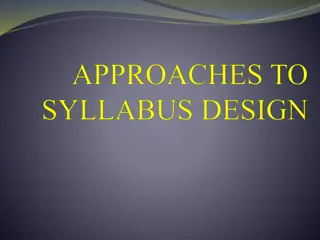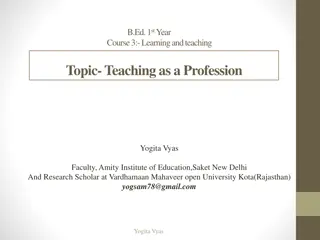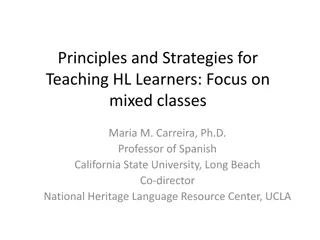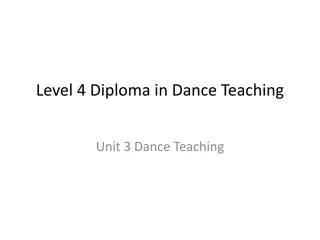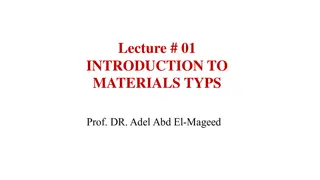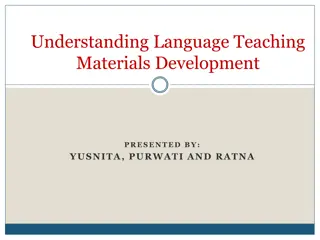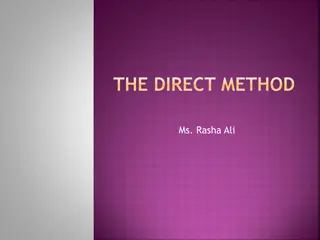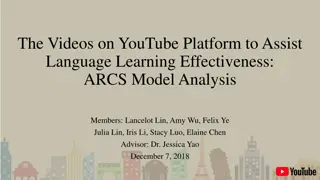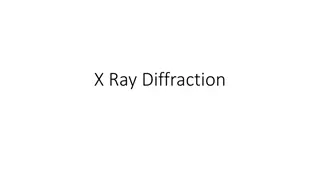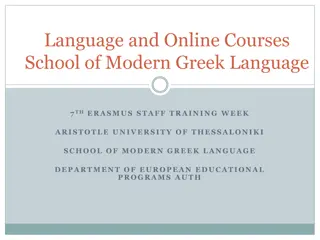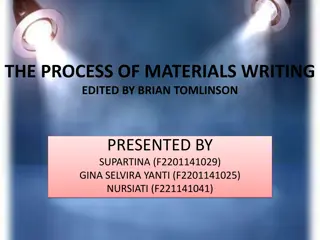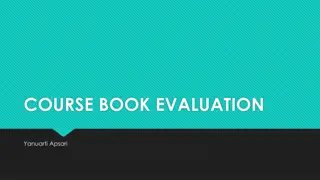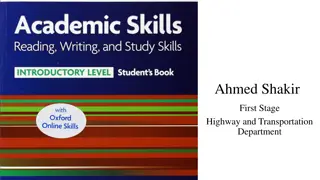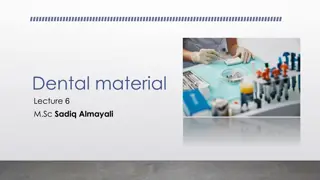Understanding the Analysis of Language Teaching Materials
This material analysis presentation by Nikodemus Yudho Sulistyo delves into the aspects to examine, methodologies for materials analysis, and connecting findings to teaching contexts. It covers the pedagogic devices, design aspects, and levels of analysis for language teaching materials, emphasizing the importance of subjective analysis and making practical use of the findings. The framework provided aids teachers in evaluating materials for effective language teaching practices.
Download Presentation

Please find below an Image/Link to download the presentation.
The content on the website is provided AS IS for your information and personal use only. It may not be sold, licensed, or shared on other websites without obtaining consent from the author. Download presentation by click this link. If you encounter any issues during the download, it is possible that the publisher has removed the file from their server.
E N D
Presentation Transcript
MATERIAL ANALYSIS Presented by Nikodemus Yudho Sulistyo F2201141018
INTRODUCTION This part will try to answer the questions: What aspects should we examine? How can we examine materials? How can we relate the findings to our own teaching contexts? of materials
ASPECTS OF AN ANALYSIS OF LANGUAGE TEACHING MATERIALS (LITTLEJOHN, 2011:183)
ASPECTS OF AN ANALYSIS OF LANGUAGE TEACHING MATERIALS Pedagogic device: methodology of the materials and the linguistic nature of their content. Publication relates tangible or physical aspects of the materials. Design relates to the thinking underlying the materials. to the
EXAMINE THE MATERIALS Level of Analysis of Language Teaching Materials:
Level Description Statements: audience, the type of materials (general/specific purpose), etc. It can also go beyond this: physical aspects (papers, number of pages, etc.). 1: What is there? Objective publication date, the intended Level Subjective Analysis To define what the task is. Questions concerning content. 2: What is required of users? process, focus, and
Level 3: What is implied? Subjective Inference Making statements of the overall aims of the materials. Making conclusion proposed for teachers and learners. Making a conclusion about what appears to be the roles of the materials as a whole (in facilitating language learning and teaching). about the roles
MAKE USE OF THE FINDINGS FROM THE ANALYSIS The analysis (framework) is relevant to: teacher s own professional development, designers critical self-evaluation, and researcher s study of language teaching. Material Evaluation: Revealing the underlying nature of a set of materials so that the teacher-analyst can evaluate the materials and decide the pedagogic worth relative to the proposed context of use (target situation used). materials
Materials Design: The process of applying the schedules for analysis to their development or in piloting. Teacher s professional development: Offers considerable teachers in understanding teaching style, and comfortable or uncomfortable with the way that materials propose. own work under insights and their they aids own are why
CONCLUSION Materials are not a closed box and reveal. By guiding the materials, the model proposed aids the teacher-analyst to internal character. The analytical framework may be seen as potentially empowering learners, educational administrators, and others to voice their needs and take more control over the materials where they are involved. deconstruction of see the materials teachers,
THANK YOU
EFL CURRICULUM AND TEACHING MATERIAL DEVELOPMENT SELECTION OF MATERIALS BY : LEROY A. WELLY NIM : F2201141015
SELECTION OF MATERIALS The coursebook has become an almost universal element of ELT, playing as it does a vital and positive part in the everyday job of teaching and learning of English (Hutchinson and Torres, 1994). What makes it vital to develop even more accurate and revealing ways of evaluating and selecting coursebooks is that materials themselves have evolved into more complex objects. Materials today frequently offer packages for language teaching and learning which include workbooks, teacher s guide, audio and video and even CALL programmes with precise indications of the work that teachers and learners are to do together in a way that effectively structures classrooms lesson (LittleJohn, 1998:1990)
Littlejohn rightly observes, we need to be able to examine the implications that use of a set of material may have for classroom work and thus come to grounded opinions about whether or not the methodology and content of the materials is appropriate for a particular language teaching context (Littlejohn 1998 : 190 1) The number of variables that affect the success or failure of coursebooks in particular contexts have made it necessary to identify appropriate criteria on which to base these decisions.
THE ROLES AND FUNCTIONS OF COURSEBOOKS Coursebooks provide teachers and learners with a range of professionally developed materials within tried and tested syllabus structure , allowing teachers to spend their valuable time more on facilitating learning than materials production (Bell and Gower, 1998:116) The cousebooks are used flexibly, they can be adapted and supplemented to meet the needs of specific classes (Bell and Gower,1998:117)
Bell and Gower 1998:117) state the following advantages for the use of cousebooks : Coursebooks fulfill a wide range of practical needs, particularly in contexts where English is being taught in a non-English-speaking environment and where teachers either lack training or sufficient time to analyse each group s needs. The coursebook helps provide a route map for both teachers and learners, making it possible for them to look ahead to what will be done in a lesson as well as to look back on what has been done. Coursebooks provide structure and predictability, which help give participants in social interactions like lessons a safe base, a platform for negotiation and exploration. By dealing with a certain amount of routine work for teachers, the coursebook frees them to attend to more important aspects of lesson planning (including materials adaptation and supplementation), and to concentrate on using their creative skills. Coursebooks provide teachers, particularly those lacking in training and experience, with a sense of self-confidence and security. Most coursebooks ared designed and developed by experts in the field, conversantwith current theoretical approaches and methodological practices. The quality of sophistication in their design, content and organization would be difficult to match with home-grown materials. Coursebooks can act as agents of change, allowing innovative ideas to be introduced within their structured framework in a way that enables teachers and leaners to develop in harmony with these new ideas. Indeed, Edge and Wharton (1998) see the ELT coursebook functioning as a genre of mass communication, where its authors can enter into positive dialogue with teachers and students on a number of issues of current significance to ELT professionals.
Bell and Gower 1998:117) state the following advantages for the use of cousebooks : Coursebooks fulfill a wide range of practical needs, particularly in contexts where English is being taught in a non-English-speaking environment and where teachers either lack training or sufficient time to analyse each group s needs. The coursebook helps provide a route map for both teachers and learners, making it possible for them to look ahead to what will be done in a lesson as well as to look back on what has been done. Coursebooks provide structure and predictability, which help give participants in social interactions like lessons a safe base, a platform for negotiation and exploration. By dealing with a certain amount of routine work for teachers, the coursebook frees them to attend to more important aspects of lesson planning (including materials adaptation and supplementation), and to concentrate on using their creative skills. Coursebooks provide teachers, particularly those lacking in training and experience, with a sense of self-confidence and security. Most coursebooks ared designed and developed by experts in the field, conversantwith current theoretical approaches and methodological practices. The quality of sophistication in their design, content and organization would be difficult to match with home-grown materials. Coursebooks can act as agents of change, allowing innovative ideas to be introduced within their structured framework in a way that enables teachers and leaners to develop in harmony with these new ideas. Indeed, Edge and Wharton (1998) see the ELT coursebook functioning as a genre of mass communication, where its authors can enter into positive dialogue with teachers and students on a number of issues of current significance to ELT professionals.
MATERIALS EVALUATION AND SELECTION Evaluation, like selection, is a matter of judging the fitness of something for a particular purposes. Selection of the material inevitably involves, subsumes, a process of evaluation, evaluation can be undertaken for a variety of purposes and carried out in variety of ways. In selection the materials, what assume primary important is the analysis of learner needs and interests and how these are addressed. Consequently, in the selection of materials usually it is the most appropriate rather than the best that wins. Evaluation of the material would involve assessing how effective and useful the materials are found to be in actual use by a specific group of teachers and students or how effective they may have been in promoting learning, selection material is concerned with the potential that a set of materials may have in effectively and efficiently supporting learning and teaching opportunities. McDonough and Shaw (1993:79),evaluation of materials in this manner is just one part of a complex process and that materials once selected can only be judged successful after classroom implementation and feedback .
EXISTING PROPOSAL FOR EVALUATING MATERIALS two main dimension:publication, which refers to the tangible or physical aspects of the materials, and design, which relates to the thinking underlying its production and use including its aims, how the tasks, language and content in the materials are selected a focusing on materials as a pedagogic device, Littlejohn s (1998) analysis containts nd sequenced and the nature and focus of the content. Cunningsworth s (1984,1995) proposal for materials evaluation, taking as it does the learner s context and learning principles as its starting point. Tomlinson (1998) says that the value of the materials for him lies in their effectiveness in encouraging learners to make discoveries for themselves through self-investment, through intellectual, aesthetic and emotional engagement with authentic input, through the sensitivity to learners readiness to learn, supported by opportunities for genuine interaction and purposeful communication.
FRAMEWORK FOR THE SELECTION OF COURSEBOOKS There are two stages need to be considered in selecting the material: The first stage would consist of assessing the content of the book in relation to its professed aims. The second stage of analysis would involve assessing the effectiveness of materials in terms of the specific needs and context of the intended learners as well as how well they serve the teaching-learning process.
The framework propose basically addresses this stage of evaluation and consist of three broad categories, each assessing the potential validity of the materialss in relation to: The learners need, goals and pedagogical requirement; The teacher s skills, abilities, theories and beliefs: and The thinking underlying the materials writer s presentation of the content and approach to teaching and learning respectively. 1. 2. 3.
PSYCHOLOGICAL VALIDITY The need for students-centeredness in recent years has made it necessary to conduct some sort of needs analysis, whether in the construction of a syllabus or a set of materials. Since this involves not just communicating within the classroom but, ultimately, in the real world outside, the material must also take into account students longer-term goals. In terms of materials, thie means that experience of working with the activities contained in them should provide students with confidence in their ability to communicate despite difficulties. (Hall, 2001:230 1). Tomlinson (1998) notes, the most significant role of materials is to involve students in desicion-making about their own learning. One way to channel this is to channel their energies towards making existing materials more relevant and motivating; another would be to involve them in generating their own materials out of the reading and listening text provided, as well as other source materials , to suit their own level and interest.
PEDAGOGICAL VALIDITY Current trends in education, technological advances, information explosion and the communications revolution have all come together to cause new and diversified demands to be made on the teacher. Teacher not only tend to their learner s linguistic growth and development but they are continually improve and develop their own skills and abilities and acquire the new ones. This require teachers not only to reflect on their practice (Schon, 1983; Richards, 1993) but also calls for a certain attitude of openness to new possibilities and a desire to continue to learn. A commercial coursebook can play an important role in teacher development if it offers teachers the opportunity to learn more about the language and about the approaches to teaching in a way that allows them to integrate new ideas into their experiences of reflective practice to achieve a synthesis of a wide variety of teaching-related schemata (Edge and Wharton, 1998). Couse material can motivate teachers to explore possibilities for self-actualization, restricted only if the teacher is reluctant to grow professionally. Edge and Wharton point out that the most obvious prerequisite for teachers to take responsibility for their professional development is a choice. Experienced teachers are known not to follow the script of a coursebook inflexibly: They add,delete and change the tasks at the planning stage, and they reshape their plan s during the lesson in response to the interactions that take place (Edge and Wharton, 1998: 300).
PROCESS AND CONTENT VALIDITY The design of a coursebook and the way in which its authors intend it to be used is an essential part of its theoretical position. This set of criteria, therefore, relates to the overall view the coursebook writer holds, or wishes to project, about the nature of language, the nature of language learning and his educational philosophy in general. Coursebook also relates to the way in which these views are carried over into the tasks and activities that learner are require to perform and the nature of these activities in term of their clarity and coherence of presentation, their sufficiency, accessibility and appropriacy. The information gathered under this category thus relates to methodology, content, format, layout and design features of the material.
There has been recent awareness that coursebook evaluation is not a straight-forward exercise and that depending on its purpose and the context of use it can embrace different perspectives and can be multidimensional (external and/or internal: static and/or dynamic).



